Our cultural landscape has always included museums in a significant manner. They give us the chance to discover more about our past, our culture, and the society we live in. They serve as hubs for our relationships with one another and our history. However, museums have come to a fork in the path recently. Museums now face both new possibilities and challenges as a result of the development of digital technologies and shifting cultural attitudes.
The need to remain relevant in a world that is changing quickly is one of the biggest challenges that museums are currently confronting. Museums were once thought of as immobile repositories of information with exhibits that hardly ever changed. However, people want to see something brand-new and exciting each time they attend a museum in today's fast-paced society. Due to this, many museums now use interactive displays, multimedia demonstrations, and hands-on activities as part of their exhibits.
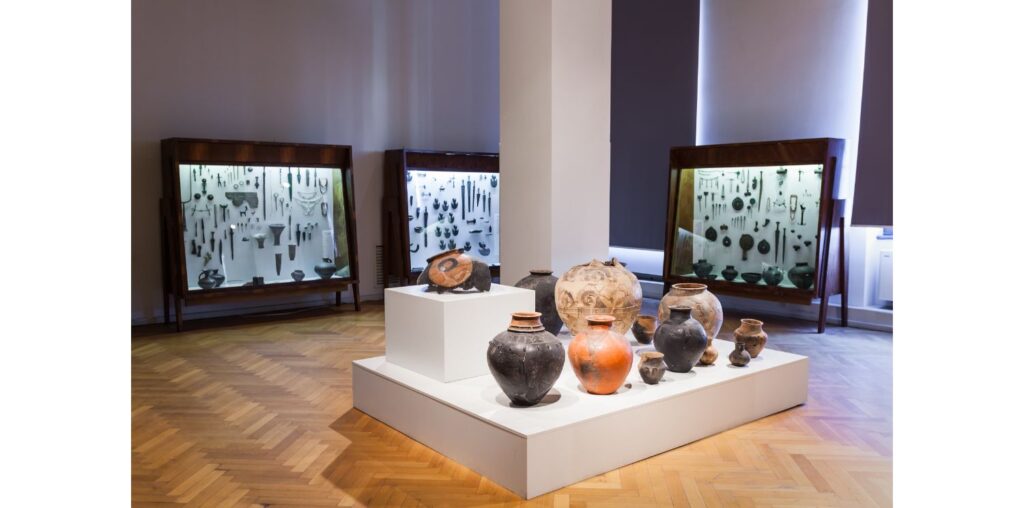
The requirement for institutions to adopt technology presents another difficulty. The way we engage with the world has changed dramatically as a result of digital technologies, and museums are no exception. With engaging touchscreens, virtual reality adventures, and augmented reality displays, many museums are now utilizing digital technology to improve their exhibits. Visitors can interact with the displays in fresh and engaging ways as a result, bringing history and culture to life.
Additionally, there is demand on museums to diversify and be more inclusive. For a long time, museums were thought of as exclusive establishments that served a narrow swath of society. However, there has been a drive in recent years to make museums more open to visitors from all backgrounds and cultures. As a result, there is now a bigger emphasis on inclusivity in museum displays, with a focus on sharing the stories of underrepresented and marginalized groups.
Additionally, financing and sustainability issues are a problem for museums. Government financing and private donations are two common sources of support for museums, but they are not always dependable. Additionally, there is growing demand on museums to improve the sustainability of both their operations and the exhibits they display. As a result, eco-friendly behaviors and the use of renewable energy sources are being given more attention.
Despite these difficulties, museums continue to be an important component of our cultural environment. They give us the opportunity to discover our history and develop deep relationships with one another. Museums can keep playing a crucial role in forming our cultural identity and our knowledge of the world around us by embracing new technologies and implementing more inclusive and sustainable practices. Museums are at a juncture as we advance into the twenty-first century, but they also have the chance to advance and flourish unlike ever before.
Museum at the Crossroads
Museums are frequently pictured as locations where historical relics and works of art are preserved and displayed. But in order to remain relevant and engage visitors, museums must change and evolve along with our culture. Many museums have recently found themselves in a precarious position as they grapple with the opportunities and challenges presented by the digital era.
The evolving expectations of visitors are one of the biggest issues confronting museums. People are increasingly seeking immersive and interactive encounters as technology develops. Through the use of cutting-edge technologies like virtual and augmented reality, multimedia displays, and other interactive elements, they want to be able to interact with shows in fresh and creative ways.
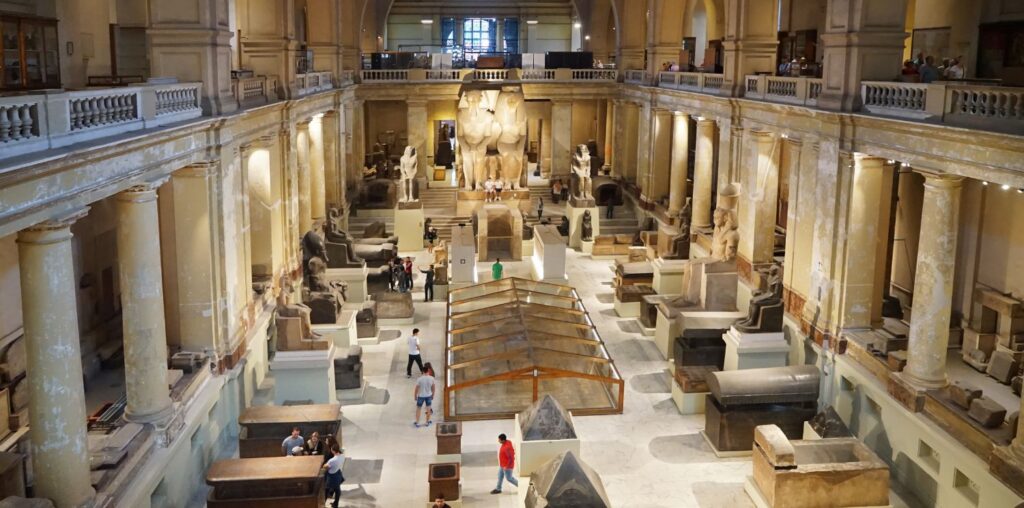
Government financing for the arts is continuing to decline in many nations, which puts financial strain on museums. In order to thrive in this climate, museums need to develop new revenue streams. Some of these include securing business sponsorships, holding special events, and generating sales of merchandise and tickets.
Many museums are reinventing themselves as cultural hubs that provide a variety of experiences in reaction to these difficulties. They are developing engaging interactive exhibits that let visitors connect with the displays in fresh and creative ways, like by using touchscreens, virtual reality headsets, and other electronic devices. Additionally, they hold concerts, movie screenings, and other cultural events in addition to providing workshops, lectures, and other educational programs.
The trend toward increased inclusivity and diversity is another one that is influencing how museums will operate in the future. Museums are working to include a broader variety of voices and perspectives in their exhibits and programs as they become more aware of how important it is to reflect the diversity of their communities. This includes developing exhibits and programs that are available to people with disabilities and other marginalized communities, as well as showcasing the artwork and artifacts of underrepresented groups.
Finally, museums are searching for strategies to interact with visitors outside of their physical boundaries. By sharing photos, videos, and other material that highlights their collections and programs, museums have new ways to connect with people who might not otherwise visit their exhibits on social media and other digital platforms. This has the potential to involve people who might not otherwise have access to the cultural and educational tools that museums provide and to reach a much larger audience.
In conclusion, as museums adjust to the opportunities and challenges of the digital era, they are going through a period of rapid change and transformation. They must reinvent themselves as cultural centers that provide a variety of experiences and programs if they want to remain relevant and engage tourists. Museums can continue to be important centers of knowledge, creativity, and cultural interaction in our society by embracing new technologies, fostering inclusivity and diversity, and engaging new audiences.
Get Creative with Home Improvement Projects Inspired by Museum at the Crossroads!
I. The benefits of taking on home improvement projects, such as increasing home value and personal satisfaction
Home improvement initiatives can provide homeowners with a variety of practical and emotional benefits.
Here are a few examples of the advantages of home improvement:
- One of the most evident advantages of home improvements is the potential increase in property value. Bathroom and kitchen renovations, the addition of a deck or patio, and flooring replacement can all increase a home’s value and enhance its appeal to potential purchasers.
- Functionality can also be enhanced through home improvement initiatives. For instance, adding more storage capacity, upgrading the electrical or sewage systems, or reconfiguring the living spaces can make a home extra livable and enjoyable for its occupants.
- The completion of a home improvement endeavor can result in a sense of self gratification and accomplishment. Observing the fruits of one’s labor can be gratifying, and the enjoyment of a new and improved space can enhance one’s well enough and quality of life.
- Energy efficiency: Many home improvement initiatives, such as installing the new windows or upgrading insulation, can also improve a home’s energy efficiency. This can save money on energy costs and reduce the environmental impact of a residence.
- Creativity and self-expression can be fostered through home improvement initiatives. The process of selecting colors, materials, and design features that reflect one’s personal style can be enjoyable and rewarding.
Overall, undertaking home improvement initiatives can have a significant impact on an owner’s quality of life, providing both practical and emotional benefits.
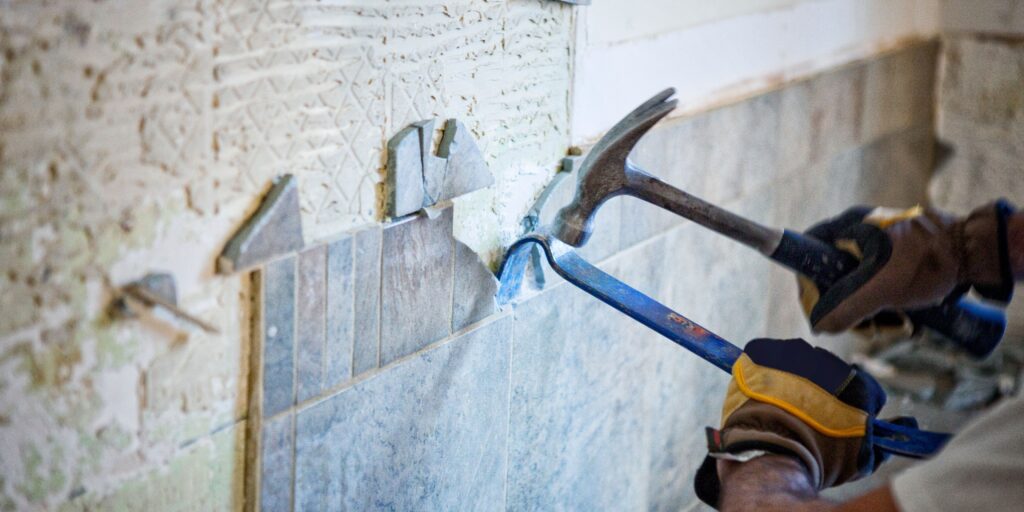
II. Project 1: Art-Inspired Wall Decor
Art can be an excellent source of ideas for original and inventive wall decoration ideas.
The Museum at the Crossroads can provide an abundance of ideas for do-it-yourself projects that add personality and appeal to any room in the house.
Here are some samples of wall decoration endeavors inspired by art:
- Create a wall art by arranging an assortment of artworks in various styles and media. Included in this category are paintings, photographs, engravings, and even textiles. Choose pieces that complement one another in color and subject matter, and use frames that are similar or complimentary in design.
- Create a mural that is inspired by a beloved piece of art or an artist. This can be accomplished with stencils, free – hand painting, or wallpaper. Murals can be a wonderful way to add depth and interest to a room, and they can also be a creative and enjoyable do-it-yourself project.
- Use textiles, such as tapestries or fabrics, as wall hangings to create textile art. This can be an excellent method to add color and texture to a room, as well as a topic of conversation. Consider using a wooden dowel or an ornamental rod to add visual interest to the hanging textiles you select.
- Create original works of art inspired by the Museum at the Crossroads’ collection. This includes paintings, sketches, and even sculptures created from discarded objects. Display your works in simple frames or on canvas to add a personalized feel to your interior design.
By using art as a source of inspiration for wall decor, you could indeed create a unique and individualized space that reflects your personal style and interests.
Whether you decide to create a gallery wall or a mural, the options for art-inspired home decor endeavors are limitless.
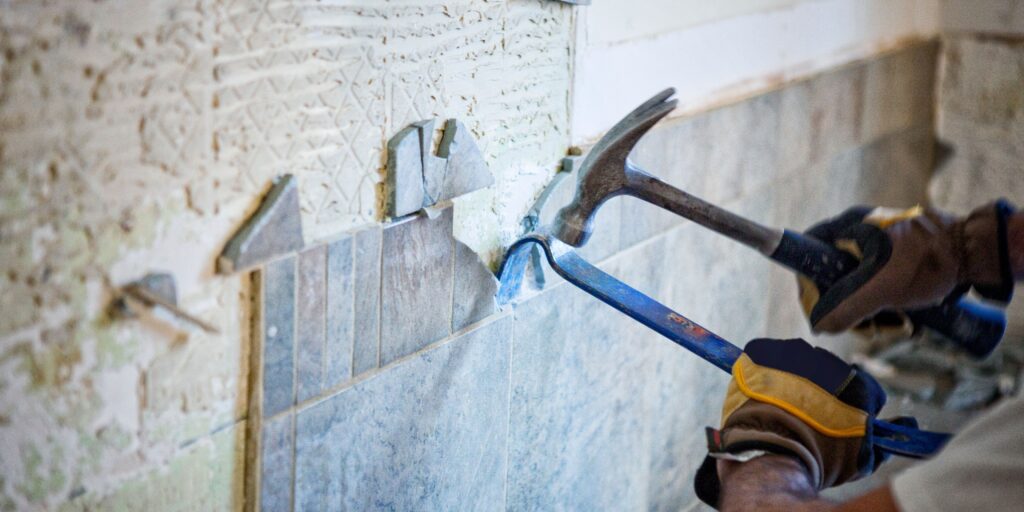
III. Project 2: Repurposed Furniture
The Repurposed Furniture Initiative
The collection of historical artifacts at the Museum at the Crossroads can inspire inventive furniture repurposing ideas.
Not only does repurposing furniture give old pieces new life, but it can also be a satisfying and enjoyable DIY endeavor.
Here are some examples of initiatives inspired by the Museum at the Crossroads that repurpose furniture:
- Repurpose an ancient trunk or chest into a functional and distinctive coffee table. This can be accomplished by attaching legs to the base of the trunk and a flat glass piece or wood on top. You can store blankets, literature, and other items in the trunk.
- Transform a vintage dresser or vanity into a lovely and practical bathroom vanity. This can be achieved by removing the countertop and installing a basin and faucet in its place. Apply new paint and hardware for a revitalized appearance.
- Adding planks of wood across the rungs of an old ladder will transform it into a bookshelf. Use supports to secure the shelves, then apply paint or stain to complete the appearance.
- Utilize a worn-out chair or stool as a plant pedestal. This can be accomplished by removing the seat and affixing a wooden tray or circle on top. Use the component to display houseplants in a unique and eye-catching manner after painting or staining it.
By repurposing furniture, you can create one-of-a-kind and personalized items that add character and appeal to your interior design.
With a little imagination and creativity, the possibilities for furniture repurposing projects are limitless.
Richmond, CA Residents Urged to Prioritize Garage Door Safety in Compliance with Building Standards
You want to make sure your family and possessions are secure as a homeowner in Richmond, California. Even though you may take precautions like setting up security systems and locking doors, it’s crucial to remember that one of your home’s most essential entry spots is the garage door.
Compliance with these standards is essential to preventing accidents and injuries because the California Building Standards Code (CBSC) has precise requirements for garage door safety. It is your responsibility as a responsible resident to make sure that your garage door complies with these safety standards.
All residential garage doors placed after January 1, 1991 are required by the CBSC to have an automatic reversal mechanism that engages when the door comes into contact with an obstruction. The purpose of this safety feature is to guard against entrapment and harm brought on by a shutting garage door.
In order for garage doors to operate correctly, regular maintenance is also required. This entails making sure the door opener is operating properly and inspecting the door’s springs, wires, and tracks.

Many homes require garage doors because they give residents protection and convenience. However, if not used and kept correctly, they can also be hazardous. Accidents involving garage doors can result in critical injuries or even death. Homeowners must emphasize garage door safety by adhering to proper maintenance and usage instructions. We will offer some advice for maintaining garage door safety in this piece.
- Recurring Testing And Inspection
Regular inspections and testing are among the most crucial things you can do to guarantee garage door safety. Make sure the door’s springs, cables, pulleys, and other hardware are in excellent working order by looking over them. Any indications of wear or harm need to be repaired right away. You should also check the door’s balance and reverse system. Put a roll of paper towels in the path of the door to try the door’s reversing mechanism. It might be time for a repair or replacement if the door does not reverse after coming into touch with the paper towels.
- Avoid Putting Your Hands or Fingers Near Pinch Areas
There are numerous pinch spots on garage doors that, if fingers or hands are caught there, can result in life-threatening injuries. Make sure everyone in your home understands to keep their hands and fingers away from the door’s moving components to avoid accidents. Children need to be watched closely and told not to play close to the garage entrance.
- Use of the Garage Door Opener and Control Properly
The majority of contemporary garage doors include an actuator and remote control. However, improper use of these tools can make them hazardous as well. Never allow children to play with the remote control and make sure it is out of their grasp. Additionally, while the door is opening or closing, you should always maintain it in your line of sight. Stop the door right away and look into any strange noises or movements you observe.
A crucial aspect of house maintenance is ensuring the security of the garage door. Regular inspections and testing, avoiding pinch spots with hands and fingers, and using the garage door opener and remote control correctly are all crucial steps in preventing mishaps and injuries. These recommendations will help you maintain a secure and functional garage door for many years to come. Remember, it’s best to contact an expert for repairs or replacement if the door shows any signs of wear or damage or if it’s not working properly.
Residents of Richmond, California are encouraged to put garage door safety and adherence to building codes first in light of these risks. Garage doors can benefit from routine maintenance and inspection in order to detect potential problems before they become major safety risks. Additionally, homeowners ought to think about replacing their old garage doors with more contemporary, secure models that meet or surpass CBSC standards.
Your garage door’s compliance with regulations and safety can be helped by hiring professional garage door repair in Richmond CA businesses. These businesses can offer standard upkeep, inspections, improvements, and replacements as needed.
In conclusion, Richmond, California homeowners must prioritize garage door protection. The safety of your family and property can be ensured by adhering to building codes and performing routine upkeep and inspections. Therefore, don’t ignore the protection of your garage door and take steps to make sure it complies with CBSC standards right away.
Embracing Change for a Healthier Life: Adapting to New Environments and Habits
Adapting to New Environments: Strategies for Thriving in Unfamiliar Territory It can be both exciting and intimidating to relocate to a new city or nation. On the one hand, there is the excitement of discovering new places, getting to know new people, and taking in new cultures. On the other hand, adjusting to new environments, navigating new social norms, and finding your position in a new community can be difficult.
 Moving for job, school, or personal reasons requires time and effort to adjust to a new environment. The following are some tips for prospering in uncharted territory:
Moving for job, school, or personal reasons requires time and effort to adjust to a new environment. The following are some tips for prospering in uncharted territory:
Be open-minded: Maintaining an open mind is one of the most crucial things you can do when relocating to a new setting. Try new foods, embrace new experiences, and be ready to push yourself past your comfort zone. You’ll adjust more rapidly and make the most of your new surroundings if you do this. Take the time to acquire the local tongue if you’re moving to a country where the language is different. This will not only make daily living easier for you, but it will also demonstrate that you are trying to get involved in the community.
Create a support system: Relocating can be isolating, particularly if you are unfamiliar with the area. Join clubs or groups that share your hobbies, go to local events, or volunteer in the neighborhood in an effort to meet new people. You can feel more connected and supported in your new surroundings by creating a support network.
Learn about the culture of the area: Every culture has its own traditions and societal mores. Spend some time getting to know the people and customs of your new community. This will help you steer clear of misunderstandings caused by cultural differences and leave a good impression on those you encounter.
Keep in touch with family and friends: Relocating to a new place can be difficult, so it’s crucial to keep in touch with those you care about back home. Make sure to remain in touch with loved ones by using social media, video chats, and phone calls. You may feel more rooted and connected if you have a support network outside of your new surroundings. It takes time and effort to adjust to a new environment, but with the proper strategies, you can succeed there. You can make the most of your new surroundings and build a satisfying life in your new environment by keeping an open mind, establishing a support network, and learning about the local culture.
Embracing Changes in Health: Strategies for Navigating Life’s Challenges
Change is a constant in life, and this is also true of our health.We all experience health issues at some point in our lives, whether it’s due to a new diagnosis, an accident, or just the normal aging process. Although embracing these adjustments can be difficult, doing so can make it easier and more resilient for us to deal with life’s difficulties. 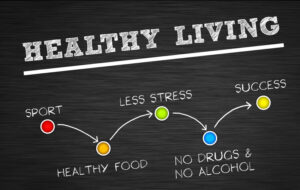
Here are some tactics for accepting health changes:
Be proactive: Taking charge of your health in the first place is the best method to adapt to changes in it.This entails maintaining a healthy diet, exercising frequently, and keeping up with routine checkups and exams. You’ll be more equipped to handle any changes that come your way if you take care of your health before any problems emerge.
Seek assistance: Handling health changes can be stressful, so it’s essential to get assistance from family, friends, or medical professionals.Never hesitate to ask for assistance, whether it be to talk about your emotions or to receive helpful advice.
Keep an optimistic attitude: One of the most effective ways to deal with changes in one’s health is to keep a positive outlook.Consider your lifestyle choices and attitude as examples of things you can control, and endeavor to discover the positive aspects of challenging circumstances.
Take action: Sometimes accepting health changes necessitates acting to alter your life for the better.This could entail beginning a new fitness regimen, changing to a healthier diet, or looking into novel therapies or treatments. Make sure to speak with your healthcare provider before taking any action.
Take care of yourself: Since dealing with health shifts can be stressful, self-care should be given priority.This could entail relaxing, participating in yoga or meditation, or doing things that make you happy and fulfilled. Although accepting changes in your health can be challenging, you can handle the challenges of life with greater ease and resilience if you use the right techniques.You can create a fulfilling and healthy existence despite health changes by being proactive, seeking support, remaining upbeat, acting, and engaging in self-care. Keep in mind that help is always accessible when you need it and that you are not alone.
In addition accepting change in our lives can be difficult, but it is an essential step for progress and development on the personal level.There are techniques we can employ to succeed in uncharted terrain, whether we are adjusting to a new environment or navigating changes in our health.
Even in the face of difficulties, we can create a satisfying and healthy life by being proactive, looking for support, remaining upbeat, acting, and engaging in self-care. We can broaden our views, pick up new skills, and develop our resilience by accepting change. So let’s accept change with an open mind and a desire to improve.
The Power of Preservation: How Museums and Garage Doors Protect Our History and Belongings
Preservation is a crucial element in protecting our history and belongings. Museums and garage doors may seem like vastly different contexts, but they share a common goal: to preserve what is valuable and protect it from damage or destruction. In this article, we will explore the power of preservation and how museums and garage doors work to protect our history and belongings.
Preservation is the act of maintaining or safeguarding something from damage or decay. In the context of history and belongings, preservation is essential in ensuring that valuable items remain intact and accessible for future generations to appreciate and learn from. Museums and garage doors are two contexts that may not seem related, but they share a common purpose in preserving what is valuable and protecting it from harm.
Preservation in Museums

Museums are perhaps the most obvious context where preservation plays a vital role. These institutions are dedicated to collecting, preserving, and displaying objects that hold cultural, scientific, or historical significance. Museums typically have a wide range of items in their collections, from ancient artifacts to modern art pieces, and it is essential to preserve each item appropriately to ensure that they remain intact and available for public viewing.
One example of how museums preserve history is through the use of climate-controlled environments. Climate control is necessary for preserving objects that are sensitive to temperature, humidity, and light exposure. Museums use specialized storage areas with controlled environments to protect objects from fluctuations in temperature and humidity, which can cause irreversible damage. Additionally, museums use UV-filtering glass in display cases to protect items from light exposure, which can cause fading or discoloration.
Another example of how museums preserve belongings is through the use of specialized conservation techniques. Museums often have dedicated teams of conservators who specialize in the care and preservation of specific types of objects. For example, paper conservators work to preserve historic documents, while textile conservators work to preserve clothing and other textiles. These specialists use a variety of techniques to repair damage, prevent deterioration, and extend the lifespan of items in the museum’s collection.
Preservation in Garage Doors
While it may not be as obvious, garage doors also play an important role in preservation. Garage doors are not only designed to protect vehicles and other belongings from theft, but they also help protect these items from the elements. A high-quality garage door can provide a barrier against wind, rain, and snow, which can cause damage or rust to vehicles and other outdoor equipment.
In addition to protecting belongings from the elements, garage doors also provide a layer of security against theft and vandalism. Garage doors are designed to be sturdy and difficult to break into, making them an excellent deterrent against theft. Additionally, some garage doors are equipped with advanced security features such as keyless entry and automatic locking systems.

Similarities between Museums and Garage Doors
While museums and garage doors may seem like vastly different contexts, they share many similarities in terms of the importance of preservation and the techniques used to achieve it.
- Shared importance of preservation
Both museums and garage doors prioritize the importance of preservation. Museums work to preserve cultural, scientific, and historical objects for future generations, while garage doors work to preserve vehicles and outdoor equipment from damage and theft. The goal of preservation is the same in both contexts: to maintain the integrity and value of what is being preserved.
- Similar techniques used in preservation
Museums and garage doors also use similar techniques in their preservation efforts. Both contexts may use climate-controlled environments to protect items from damage caused by fluctuations in temperature and humidity. Additionally, both may use specialized conservation techniques to repair and preserve items.
- Overlap in the types of items preserved
Finally, there is overlap in the types of items preserved in museums and garages. Museums may preserve vehicles and other outdoor equipment as part of their collections, while garage owners may preserve historic or valuable vehicles in their personal collections. Both contexts may also preserve other items such as artwork or artifacts.
- Differences between Museums and Garage Doors
While there are similarities between museums and garage doors in terms of preservation, there are also significant differences.
- Goals of preservation
The goals of preservation in museums and garage doors differ significantly. Museums aim to preserve items for public education and enjoyment, while garage doors aim to preserve items for personal use and enjoyment.
- Methods of preservation
The methods used in preservation also differ between museums and garage doors. Museums often have specialized teams of conservators and use advanced conservation techniques, while garage owners may simply use protective coverings or store their belongings indoors.
- Types of items preserved
Finally, the types of items preserved also differ between museums and garage doors. Museums typically preserve cultural, scientific, or historical objects, while garage owners may preserve vehicles, outdoor equipment, or other personal belongings.Check this garage door service to help you preserver your garage door and belongings.
Revitalizing Museums: How to Bring the Magic Back with Inclusivity and Technology
Museums have always been the epitome of knowledge, history, and art. But lately, they’ve been feeling a bit… well, dull. Museums have become boring for some people for a variety of reasons. The traditional museum experience, focusing on static exhibits and didactic labels, can feel stale and unengaging to some visitors, especially younger generations who have grown up in a highly interactive digital world. Additionally, museums may need to effectively communicate the relevance and significance of their collections to a wider audience, leading to a perception that the content is dry and uninteresting. Furthermore, museums may need to adapt more quickly to changing trends and technological advancements, making them feel outdated and disconnected from the world around them. To remain relevant and engaging, museums must find ways to re-imagine their offerings and create experiences that are more dynamic, interactive, and relevant to a wider audience.
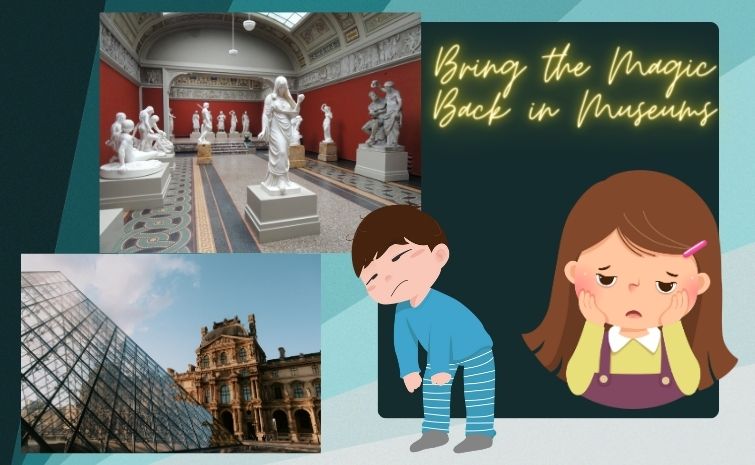
Add to the fact that the COVID-19 pandemic has led to a decline in the popularity of museums for several reasons:
- Closures and restrictions: Many museums around the world had to close temporarily due to health and safety concerns, and even when they reopened, they had to impose strict capacity limits and visitor restrictions, which may have deterred people from visiting.
- Health concerns: The pandemic has made many people wary of crowded indoor spaces, and museums, which often attract large crowds, may seem like they need to be more safe places to visit for some.
- Financial difficulties: The pandemic has affected the global economy, and many people may be cutting back on discretionary spending, including spending on cultural activities like visiting museums.
- Shift to digital: With many museums closed, people have turned to digital platforms to access cultural content, including virtual tours and online exhibitions, which may have reduced the appeal of visiting museums in person.
However, it’s important to note that the impact of the pandemic on museums has varied depending on the region and the museum. Some museums have reported a decline in visitor numbers, while others have seen an increase due to the shift to digital engagement.
The crowds have thinned, and the once lively halls now echo with emptiness. But fear not, dear readers, for I have come up with a solution to make museums popular again!
- Add a touch of magic. Imagine walking into a museum and being transported to a magical world of talking paintings and enchanted artifacts. A bit of theatrical magic would lure people back in.
- Get interactive. Museums are no longer just about looking at things behind glass cases. People want to touch, feel, and experience. So why not let them? Let visitors play with interactive exhibits and make their own art.
- Bring in the animals. Who doesn’t love animals? Bring in some live creatures for visitors to interact with. A petting zoo of historical creatures, perhaps? A dragon, a unicorn, a griffin? The possibilities are endless!
- Make it a game. Turn the museum into a giant game of hide-and-seek. Let visitors search for hidden treasures, solve puzzles, and collect rewards. A museum that’s also a treasure hunt? Sign us up!
- Get musical. Museums are known for their silence, but what if they were filled with music instead? Create a symphony of sound, with exhibits that play music when you pass by.
- Let visitors create their own exhibits. Allow visitors to create their own presentations and display them in the museum. Who knows, they might discover the next great artist!
Since museums are publicly accessible, they must comply with the Americans with Disabilities Act (ADA) regulations. This means they must ensure that their facilities are accessible to people with disabilities, which can sometimes result in a lack of creativity in exhibit design and a focus on practical considerations over artistic ones. This can also contribute to a perception that museums are boring, as visitors may feel that the exhibits are designed more for accessibility than for inspiration or enjoyment. However, museums can strike a balance between accessibility and creativity, using innovative design and technology to create exhibits that are both accessible and engaging. By doing so, museums can meet their legal obligations and create enjoyable experiences for all visitors, regardless of their abilities.
Having wheelchair ramp access in museums has several benefits, both for the visitors and the museum itself:
- Increased accessibility: Providing wheelchair access ensures that everyone, regardless of their physical abilities, can visit the museum and experience its offerings. This promotes inclusiveness and removes barriers for people with disabilities.
- Wider audience: By making the museum accessible to people with disabilities, it can attract a wider audience and potentially increase its visitor numbers.
- Improved reputation: A museum accessible to all is seen as a socially responsible and inclusive institution, which can improve its reputation and enhance its standing in the community.
- Enhanced experience: Providing accessible facilities, such as ADA-compliant railings and elevators and clear signage, can improve the overall experience for all visitors, making it easier for them to navigate the museum and access its exhibits.
- Compliance with laws and regulations: Many countries have rules and regulations requiring public buildings, including museums, to be accessible to people with disabilities. Wheelchair access helps the museum comply with these laws and avoid legal issues.
Making museums popular again in the digital age requires a combination of innovative and inclusive strategies. By embracing technology and offering virtual experiences, museums can reach a wider audience and bring their collections to people who cannot visit in person. At the same time, it is crucial for museums to also prioritize inclusivity by providing accessible facilities and promoting diversity in their exhibitions and programming.
By doing so, museums can attract a wider audience and enhance their reputation as socially responsible and inclusive institutions. In a world where technology is rapidly advancing, museums have an opportunity to lead the way in using technology to bring people together and promote understanding and appreciation of different cultures and perspectives.
Making museums popular again is about increasing visitor numbers and creating a space where everyone can come together to learn, explore, and be inspired. By incorporating inclusivity and embracing technology, museums can fulfill their role as important cultural institutions and continue to inspire future generations.
From Antiquity to Modernity How Museum Displays Can Inspire Home Improvements
Many people have always found inspiration in museums, but did you realize that they may also inspire house renovations? Museum exhibits can offer helpful insights into numerous styles and design components from many historical periods, whether you’re wanting to renovate your home, freshen up your decor, or simply acquire thoughts for your next DIY project. In this post, we’ll look at the advantages of include museum exhibits in your home remodeling plans, as well as some examples of exhibits that might inspire you and how to apply those ideas to your own house.
The Advantages of Museum Exhibitions in Home Improvement
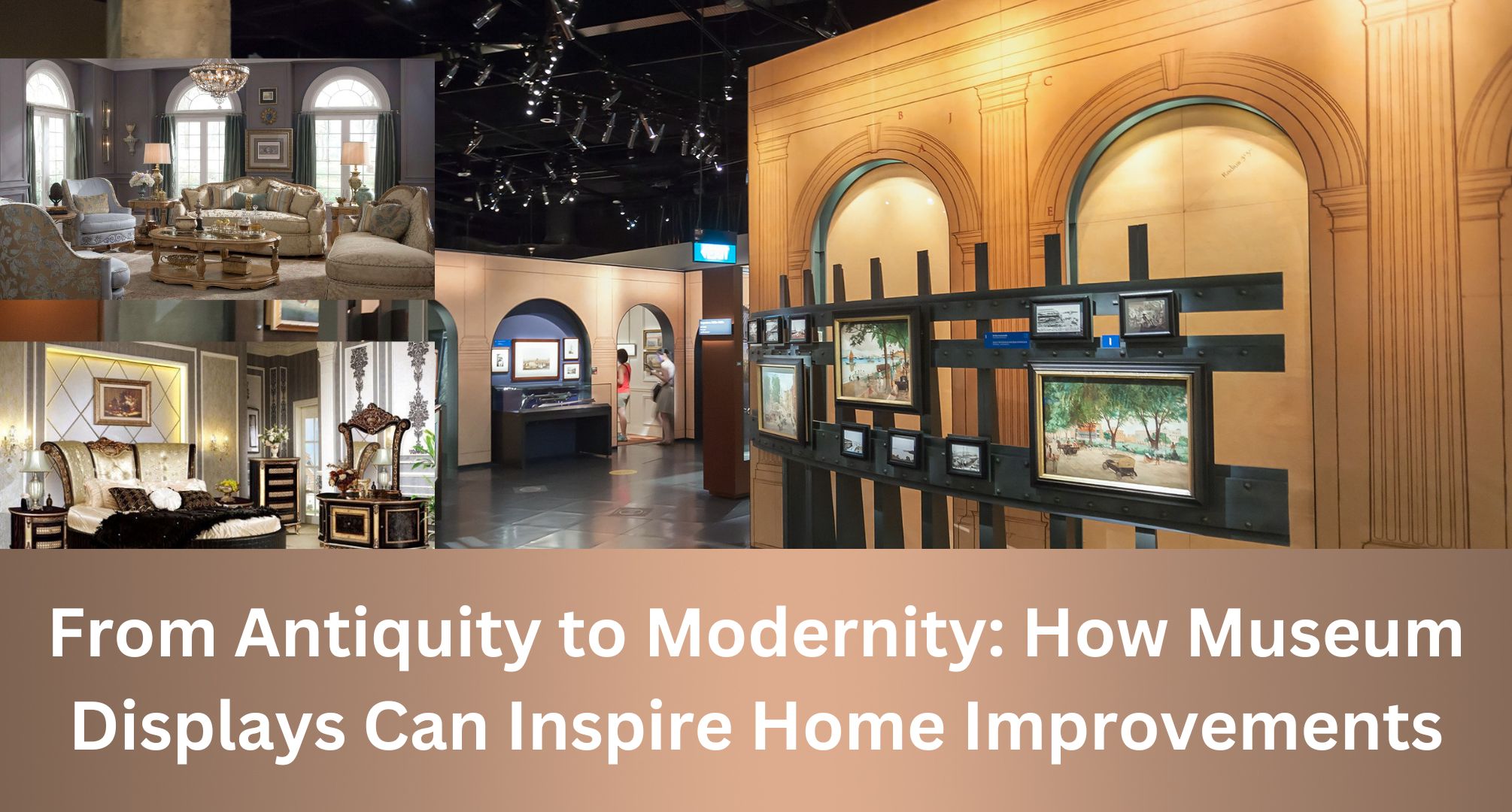
When wanting to upgrade their living environment, homeowners can profit greatly from museum exhibits. The following are a few of the most important advantages:
Inspiration: For homeowners looking for fresh ideas for their home, museum exhibits may be a terrific source of inspiration. Museum exhibits can offer fresh perspectives and thoughts that you may not have previously thought about, whether you are searching for design inspiration or ideas for your next do-it-yourself project.
Ideas for design and decoration: Museum exhibits frequently feature distinctive and fascinating design aspects that can be used to decorate your home. Museum exhibits may be a great source of ideas for home owners looking to develop a distinctive and fashionable living environment, including everything from vintage furniture and lighting fixtures to contemporary art and design.
Historical context: Museum exhibits can offer insightful historical context for various eras of design and decor. Homeowners can create a more realistic and historically accurate living space by understanding the historical context of a particular architectural style.
Value in terms of education: Museums frequently offer educational tools and information that can assist homeowners in learning more about various design aesthetics, architectural features, and other facets of home improvement. Homeowners can get important knowledge and insights that can aid them in making more educated decisions about their home improvement projects by visiting museums and perusing their exhibits.
Various museum exhibits that can serve as inspiration for home improvements
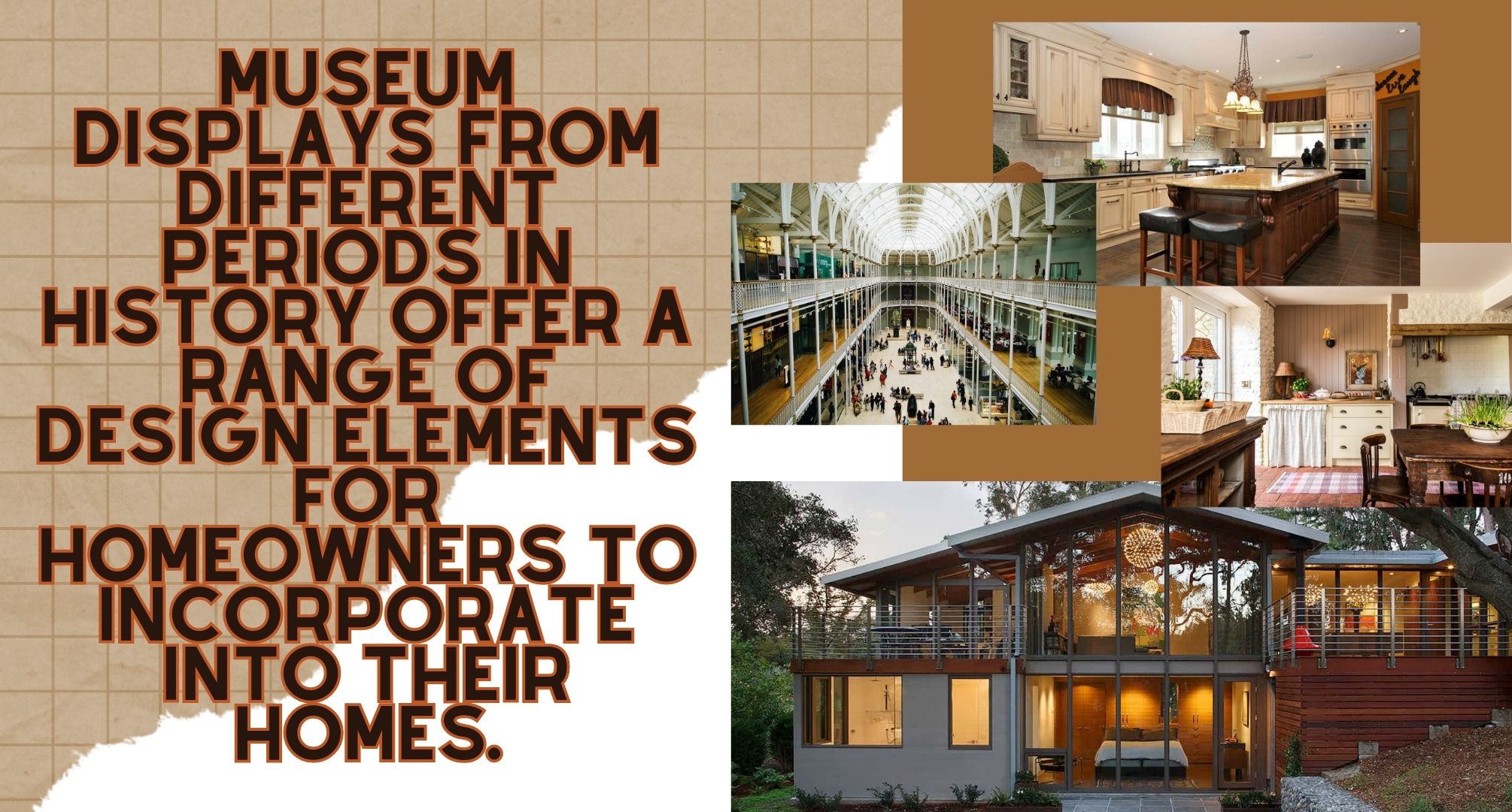
There are numerous types of museum exhibits that can motivate house renovations. Just a few instances are shown below:
Ancient: Ancient architecture, furnishings, and decorating motifs from cultures like Egypt, Greece, and Rome are frequently on display. Homeowners who want to design a traditional and timeless living room will find great inspiration from these displays.
Middle Ages and Renaissance: Homeowners who wish to establish a more traditional and opulent living environment might find inspiration in exhibits that feature Gothic and medieval architecture as well as Renaissance art and design.
Modern Era: Art Nouveau and Deco exhibits, as well as mid-century modern and contemporary design, can inspire homeowners who desire to build a more contemporary and minimalist living area.
How to Include Exhibitions from Museums in Home Improvement Plans
Here are some pointers to get you started if you want to incorporate museum exhibits into your home repair plans:
Determine a theme or style: It’s a good idea to decide on a theme or style that you want to research before you visit a museum or look through their online collections. You can narrow down your search and uncover displays that are most pertinent to your home renovation objectives by doing this.
Research museum exhibits and displays: After you’ve decided on a subject or aesthetic, you may start looking into exhibitions and displays at museums that are related to that theme. You can explore online collections and virtual displays from the convenience of your home at many museums.
Choose inspiration for your house and adapt it: As you examine museum exhibitions and displays, search for design cues and suggestions that you can employ in your own space. For instance, you might discover a contemporary piece of art that you can utilize as the center of attention in your living room or an antique lighting fixture that you can duplicate in your own home.
Once you’ve gathered ideas and inspiration from museum exhibits, it’s time to put those modifications and improvements into action in your own house. Depending on the size of your project, you could need to DIY the improvements or engage a qualified contractor. To make sure that your home upgrades come out exactly how you want them, be sure to take your time and thoroughly plan out each stage of the process.
When incorporating museum exhibits into your home remodeling plans, it’s crucial to remember not to just duplicate the exhibits themselves. Instead, take inspiration from the displays and modify the concepts to suit your individual needs and preferences. By doing this, you may design a home that is special, fashionable, and a reflection of your own likes and personality.
Conclusion
When trying to upgrade their living space, homeowners might find great inspiration from museum exhibits. Museum exhibits can offer a plethora of advantages for individuals wishing to undertake home modifications, from inspiration for design and decor to providing historical context and educational value. You can design a living space that is both lovely and practical by choosing a theme or style, researching museum exhibitions and displays, choosing and adapting ideas for your house, and putting those adjustments and improvements into action. So why not start incorporating museum exhibits into your home repair plans right away by visiting your neighborhood museum or perusing their online collections?
10 Ways Garage Door Art is Drastically Redefining Sustainability in Museums
If you thought the pinnacle of garage door excitement was a fresh coat of paint or a fancy new remote, brace yourself for the grand reveal. Garage doors, the unsung heroes of suburban homesteads, are taking a dramatic lead in the world of museum sustainability.
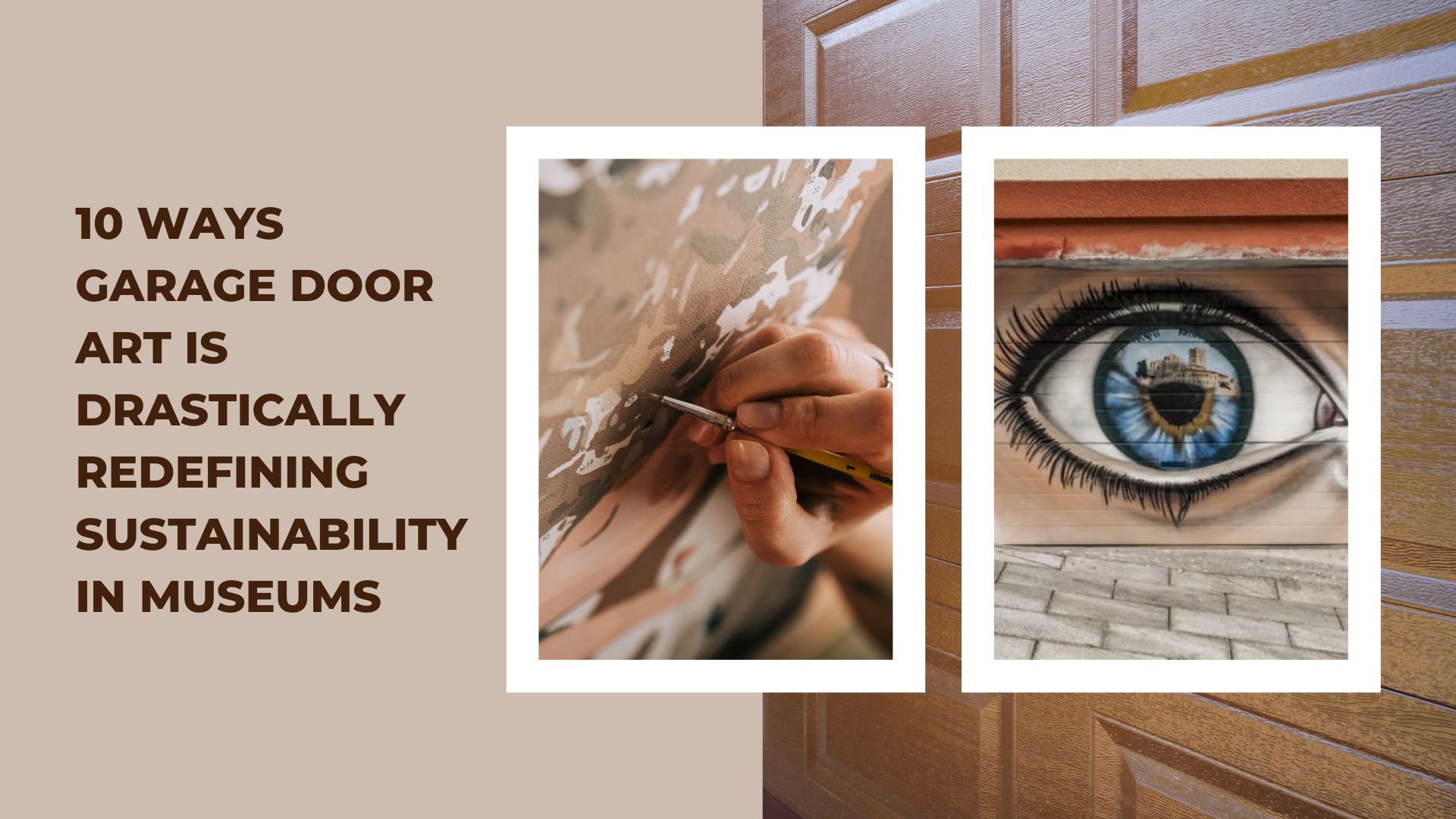
Let’s roll up our sleeves and explore eight unexpected ways garage door art installations are sparking a green revolution in museums.
1. The Marvel of Upcycling
The post-service life of a garage door often ends unceremoniously in a scrap heap. But artists and curators are rewriting this tale by upcycling these robust structures into mesmerizing outdoor art installations. It’s a radical blow against our culture of wastefulness, giving garage doors a new lease on life.
2. Artists: The Eco-Warriors in Disguise
Artists are traditionally known as trendsetters, but this trend is a leap into uncharted territory. By transforming drab, retired garage doors into captivating murals, they’re redefining their role and striding valiantly into environmental stewardship. These artistic eco-warriors are revolutionizing the museum landscape.
3. Energy Conservation: The Unexpected Benefit
Indoor museum exhibits are notorious for their high energy consumption, what with the need for temperature control, special lighting, and the works. But garage door art installations are immune to such demands. Basking in natural light, these installations slash energy consumption significantly, propelling museums towards a greener future.
4. Democratization of Art: No Entry Fee Here!
Art, when encased within museum walls, can seem aloof, accessible only to those who can afford the entry fees. But garage door art installations are changing the game. Open for viewing to any passerby, they are a slice of museum culture available for free, taking a giant leap towards the democratization of art.
5. A Facelift for Urban Spaces
Space constraints in urban museums can limit their exhibition capacity. But garage door art installations allow for a dramatic extension beyond museum walls, enhancing urban landscapes and fostering community engagement. A win-win for both the museums and the city.
6. A Boon for Local Artists
By commissioning local artists for creating these garage door art installations, museums are not only getting vibrant, unique pieces but also fostering local talent and boosting community involvement. It’s an inspiring blend of nurturing creativity and encouraging sustainable practices.
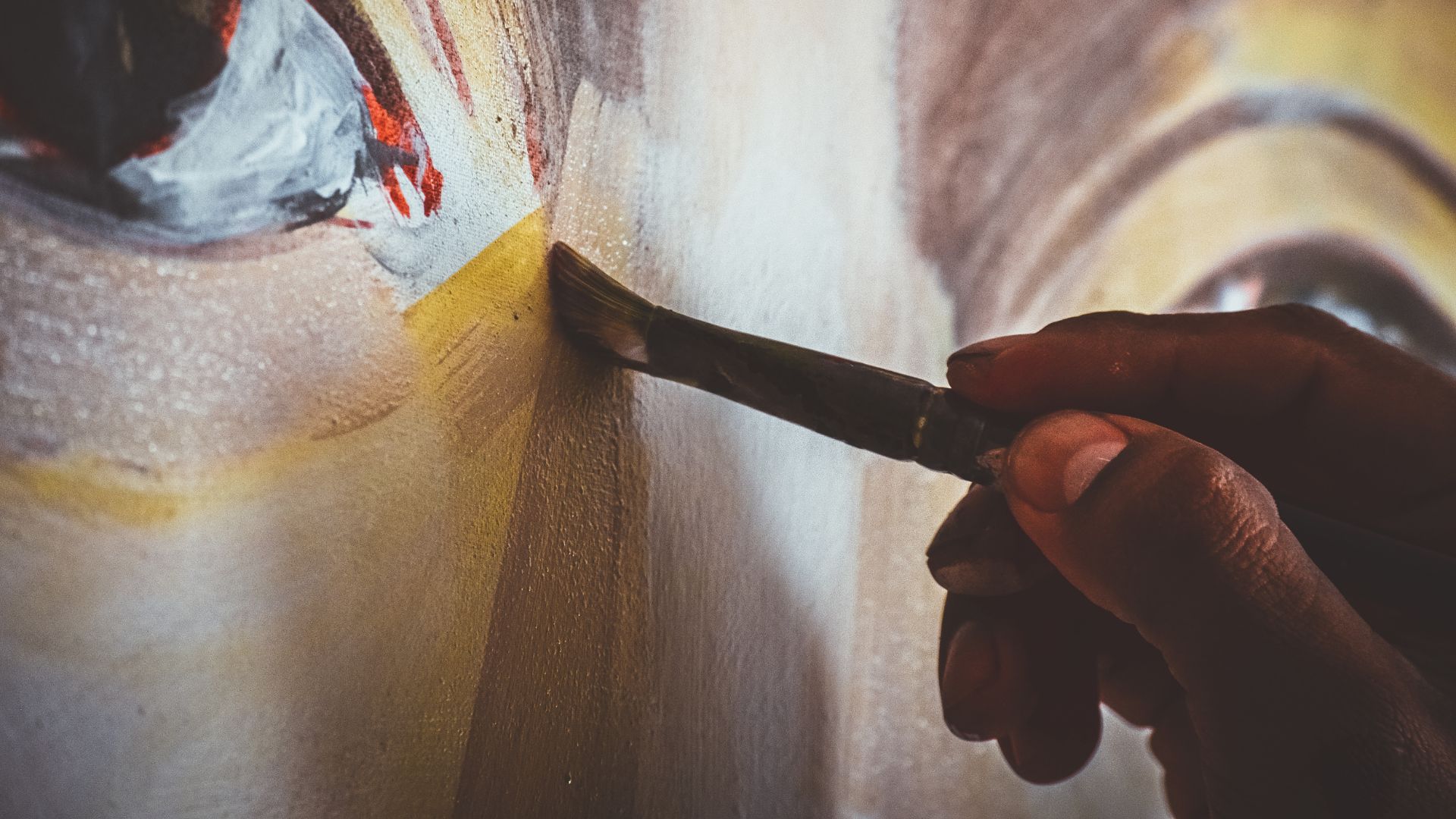
7. Driving Sustainability Discussions
Garage door art installations, beyond being visually engaging, also provoke thought. They encourage the public to rethink their perceptions of waste and sustainability, stirring vital conversations about environmental responsibility and conservation.
8. The Trials and Triumphs
Every revolutionary path comes with its share of hurdles, and the journey of garage door art is no exception. From navigating bureaucracy to overcoming skeptics who aren’t fans of unconventional art, the challenges are manifold. But these trials serve to fortify the movement’s resolve, further fueling the drive towards sustainability.
9. Reviving the Community Spirit
Garage door art installations have also proven to be an effective way of bringing communities together. Residents take pride in these locally produced works, fostering a sense of community identity and togetherness. It’s the communal spirit, combined with the celebration of art and sustainability, that makes this movement truly special.
10. Redefining Museum Spaces
Garage door installations have dynamically transformed the concept of museum space. By extending exhibits outdoors, museums break free from their physical constraints, innovatively redefining what a ‘museum’ can be while simultaneously advocating for sustainable practices.
Conclusion
The humble garage door has evolved from a functional household item into a pioneering force for sustainability in museums. This transformation serves as a compelling reminder of how creative thinking can transform ordinary objects into instruments of environmental change.
So next time you cast an absent-minded glance at your garage door, remember to see beyond its functional façade. Recognize its potential as a canvas for artistic creativity and sustainability.
Acknowledge the fact that even the most commonplace items can serve a higher purpose. A garage door is not just a garage door, after all – it could be the next star of a sustainable museum exhibit. Talk about a plot twist!
